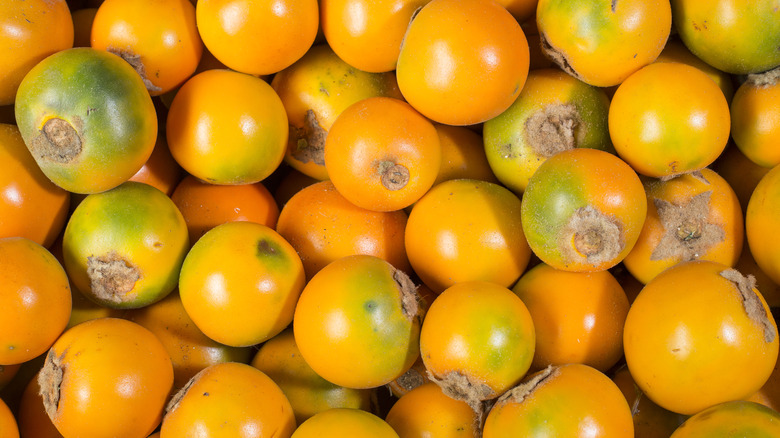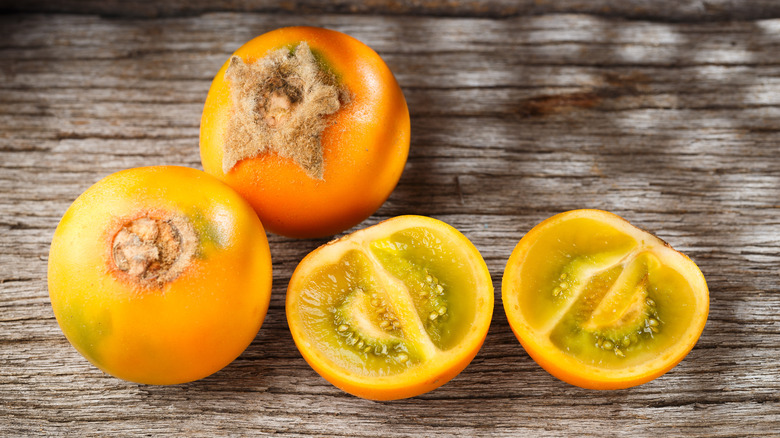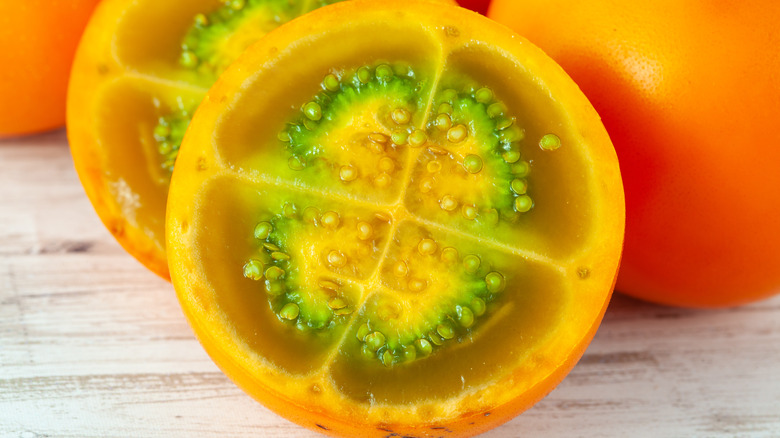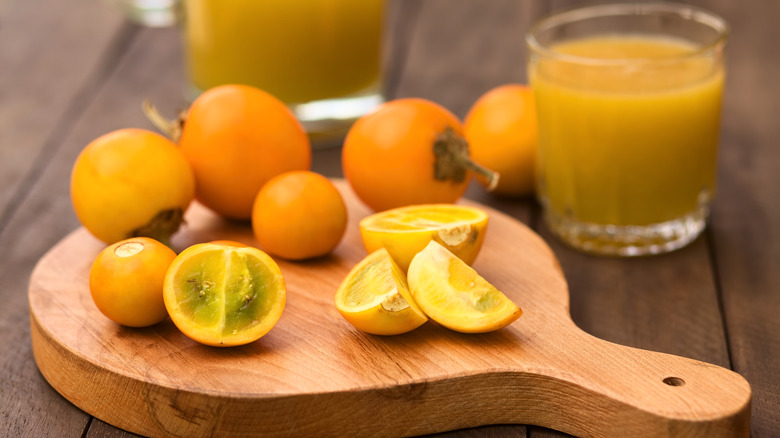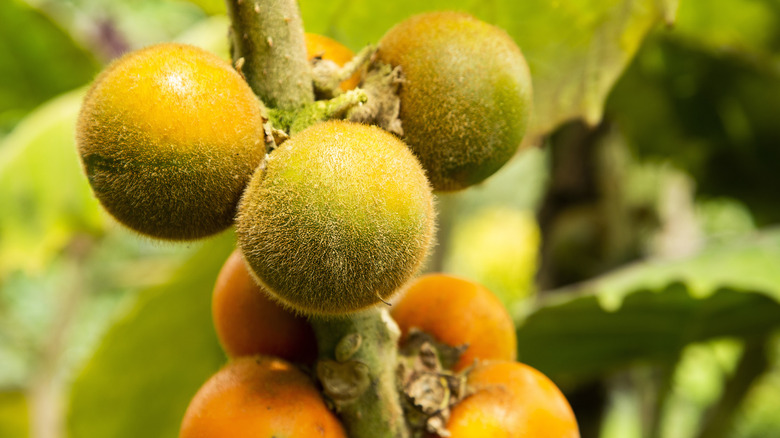Lulo Fruit Is Colombia's Cross Between Tomato And Lime
Some countries know lulo fruit as lulun, nuqui, and Toronjaludo whereas others call it the nectar of the gods or the golden fruit of the Andes. Those unfamiliar with the fruit may even mistake it for a gooseberry, a persimmon, a cherry tomato, or a tiny orange due to its appearance — but in Colombia, lulo fruit is simply known as naranjilla or little orange.
Botanically classified as Solanum quitoense, lulo fruits belong to the same family of nightshades, or Solanaceae, as tomatoes. In fact, lulo looks much like a seedy tomato when sliced into, with a pulp that's just as juicy and leaves tart liquid running down your fingers. Lulo fruit grows in clusters on small shrubs and is prized all across South and Central America for its sweet, sour, and tangy taste as well as its juicy flesh and edible seeds. Unfortunately, however, lulo fruits are extremely fragile and bruise easily. Due to this, the fruit is rarely shipped across long distances, which is why lulo remains a relatively unknown fruit outside its native South American home.
What is lulo fruit?
Although not much is known about how the lulo fruit came to be, written records indicate that the fruit has been around since at least the 17th century. Some experts claim that the lulo may actually be an even more ancient fruit, adding that it was widely eaten during the Inca Empire — possibly in the 13th century — and was known as lulum at the time. Regardless of how the fruit came to be, lulo is native to the Andes mountains and mostly grows in Colombia, Ecuador, and Peru.
With a diameter of four to six centimeters and weighing no more than 1.5 to 4.2 ounces, round lulo fruits could very easily pass off as persimmons or cherry tomatoes, but their most distinguishing feature is perhaps their skin. Lulo fruits have tough leather-like, orange-colored skins that can be .3 to .4 centimeters thick, and the fruits are only eaten when they are mature, and the skin feels soft to the touch. While the skin can sometimes be smooth, it can also be covered in fuzzy hair that can aggravate those who have sensitive hands if not removed with care.
Hidden inside the inedible skin is a juicy greenish-yellow flesh that's divided into four chambers by a thin membrane. This gelatinous flesh of lulo has a texture that is reminiscent of jelly and is speckled with an abundance of tiny edible seeds, which add a crunch to all the citrus juice that bursts from within.
What does lulo fruit taste like?
Lulo fruits have an incredibly complex flavor profile: They are sour, tart, acidic, and tangy — but also sweet and reminiscent of the tropics. Lulo has the sour notes of citruses like lime, the tang of fruits like kiwi, the sweet-sour flavors of tropical fruits like pineapple, and the tart complexity of rhubarb. While lulo fruits burst with a delicious mix of sweet, sour, tart, and tangy flavors, their exact taste will depend on where the fruit is grown and what that region's climate is like.
The flavor of the fruit will also vary depending on how it is eaten; some consider the acidity of the raw fruit to be too harsh for the tongue, which is why it's often paired with sweeteners and dairy-based ingredients that can round off its piquant flavor. Even when eaten raw, lulo fruits are often topped with a sprinkle of salt or sugar to cut through their acidic nature. On the flip side, lulo fruit's sharp flavors become more mellow when they are cooked, the eye-puckering tang subdues, and the fruit becomes a touch sweeter.
How to cook with lulo fruit
Lulo fruit can be cooked into sweet or savory preparations or eaten raw as-is, but its tough skin and thin membrane should be peeled off and discarded, leaving only the fruit's pulp and seeds for the taking. You could slice the fruit in two halves and scoop the flesh out with a spoon as you would a kiwi, or squeeze the juicy flesh directly into your mouth from its skin. The fruit can be mixed into yogurts, salads, and desserts with a sprinkle of sugar or salt, or used as a filling for baked items. Lulo's naturally gelatinous texture makes it well-suited for jams, jellies, and syrups, but it can also be added to soups and stews, and its acidity can bring freshness to heavier foods like meat.
Lulo also tastes particularly delicious when turned into a beverage or an icy treat. Some turn lulo into sorbets, ice creams, and popsicles where others enjoy lulo in juices, milkshakes, and alcoholic drinks like wines and cocktails. In Colombia, lulo is mixed with sugar and water to make the traditional drink lulada, and with corn and pineapple to make the refreshing champus. It goes fabulously with fruits like orange, pineapple, lime, and bananas; spices such as clove and cinnamon; sweet ingredients like brown sugar and condensed milk; herbs such as cilantro and mint; and meats the likes of pork and chicken in savory preparations.
Nutritional information about lulo fruit
While lulo is coveted for its layered flavor, its nutritional value is also what makes the fruit very popular. Lulo fruits are packed with vitamin A and vitamin C, which may help maintain healthy eyesight, as well as vitamin K and vitamin B6 (via Medical News Today). The fruits also contain dietary fiber that can aid digestion, help with gut issues such as constipation, improve the overall health of the gastrointestinal tract, and reduce bad cholesterol (LDL) levels, according to the Mayo Clinic.
The nutrients such as iron, calcium, and phosphorus present in lulo may help prevent conditions like osteoporosis by boosting bone strength (per the Cleveland Clinic), helping repair tissues (via Mount Sinai), and promoting the development of hemoglobin (via Johns Hopkins Medicine). Lulo (Solanum quitoense) was also one of seven Brazilian fruits in a 2016 study published in the Indian Journal of Pharmaceutical Sciences that were linked to having antioxidants and anti-cancer properties.
Where do lulo fruits grow and where can you buy them?
Because of lulo's fragile skin, the fruit is rarely exported far from where it is grown — the tropical climates of countries like Colombia, Ecuador, and Peru — but there have been several attempts to bring lulo to the United States. In 1939, lulo was featured in New York's World Fair — which hoped to promote unique produce from around the world in the States. While lulo was quite the popular fruit at the fair, it turned out to be a difficult thing to grow. Lulo is prone to root damage and requires a specific environment and uncontaminated soil to thrive. The conditions in the U.S. were found unsuitable for the cultivation, and what little was successfully grown in Florida in the 1940s was also razed by a hurricane.
Although a small number of lulo plantations now exist in the United States, Mexico, Australia, and Southeast Asia, fresh lulo fruits are mostly only found in South and Central America during the dry, summer season between December and March. That said, you may be able to get your hands on fresh lulo fruits from the few plantations that grow them in the U.S., but you're far more likely to find lulo in frozen, canned, or concentrated forms due to its frailty. If you do find fresh lulo, unripe ones can be kept for three to eight days at room temperature or a month in the refrigerator whereas ripe fruits will keep for up to 10 days in the refrigerator.

